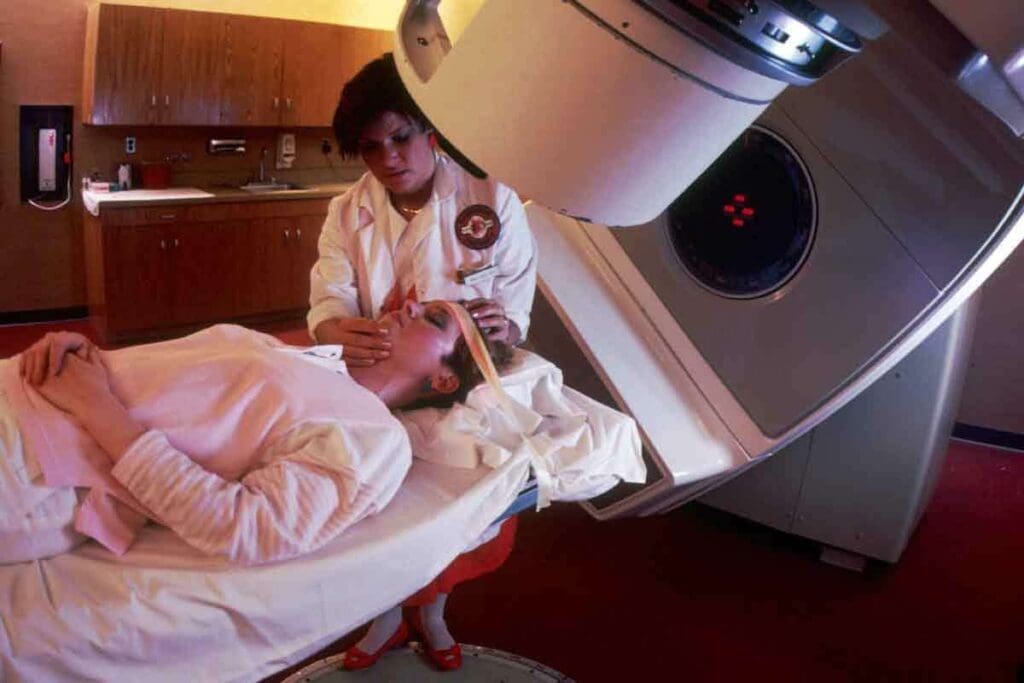Last Updated on November 27, 2025 by Bilal Hasdemir

Knowing how long a radiation treatment session lasts is important for cancer patients preparing for therapy. Most sessions typically take between 10 and 45 minutes.
The actual radiation exposure only lasts a few minutes, but preparation and precise positioning take longer. Radiation therapy usually uses x-rays, and the process itself is painless.
At Liv Hospital, we provide advanced radiotherapy with the latest technology and compassionate care. Understanding how long is a radiation treatment session takes can help patients feel more comfortable and less anxious about their treatment.
Key Takeaways
- The duration of a radiation treatment session can vary between 10 and 45 minutes.
- The actual radiation exposure takes only a few minutes.
- External radiation therapy is typically painless.
- Session duration is affected by equipment setup and patient positioning.
- Advanced radiotherapy protocols enhance the effectiveness of treatment.
Understanding Radiation Treatment Sessions

Radiation therapy is a common treatment for many cancers. It uses precise doses of radiation to target cancer cells. This treatment aims to destroy cancer cells while protecting healthy tissue.
What Is Radiation Therapy?
Radiation therapy, also known as radiotherapy, uses high-energy particles or waves to kill cancer cells. It damages the DNA of cancer cells, stopping them from growing and dividing. This treatment can be used alone or with other therapies like surgery or chemotherapy.
Purpose and Goals of Radiation Treatment
The main goal of radiation therapy is to control or cure cancer by removing or shrinking tumors. The treatment’s goals vary by case, but common ones include:
- Curative intent: To eliminate the cancer and achieve a cure.
- Palliative care: To ease symptoms, like pain, and improve life quality.
- Adjuvant therapy: To lower the risk of cancer coming back after surgery or chemotherapy.
Common Types of Cancer Treated with Radiation
Radiation therapy is used for many cancers, including:
- Breast cancer
- Lung cancer
- Prostate cancer
- Head and neck cancers
- Brain tumors
The length of radiation therapy varies based on the cancer type, stage, and patient needs. Knowing about radiation treatment sessions helps patients prepare for their journey.
How Long Is a Radiation Treatment Session?

The length of a radiation treatment session depends on several factors. These include preparation time and the actual treatment. While the treatment itself is painless and quick, the total time can vary.
Average Duration of a Single Session
A radiation treatment session usually lasts between 10 to 45 minutes. This includes both preparation and the treatment itself.
- Preparation Time: A lot of the session is spent getting the patient ready and setting up the equipment.
- Actual Treatment Time: The actual radiation time is just a few minutes.
Breakdown of Time: Preparation vs. Actual Treatment
Most of the session is for preparation. This includes:
- Positioning the patient
- Aligning the radiation equipment
- Verifying the treatment plan
The actual radiation delivery is quick, taking only a few minutes. This shows how important precise preparation is for effective treatment.
First Session vs. Subsequent Sessions
The first radiation treatment session is longer than the rest. It includes extra steps like:
- Detailed simulation and planning
- Verification of the treatment plan
- Patient education on what to expect
Later sessions are quicker because the setup is already done from the first session.
Knowing about the duration and parts of a radiation treatment session helps patients prepare. It reduces anxiety and makes the experience better.
The Anatomy of a Radiation Treatment Appointment
Knowing what happens during a radiation treatment can ease worries. It helps patients know what to expect. The process includes several important steps to ensure treatment is done right.
Check-in and Initial Preparation
When you arrive, you’ll check-in at the desk. You’ll need to show ID and insurance details. Then, you’ll wait until it’s time for your treatment.
Before treatment, you’ll change into a hospital gown. You’ll also remove any jewelry or clothes that could get in the way.
Positioning and Immobilization
Getting the right position is key for radiation therapy to work. Radiation therapists use tools and methods to position you correctly. They might use molds, casts, or masks to keep you steady.
Laser beams help align you with the treatment machine. Before treatment, you might get tattoos or marks on your skin to guide the therapists.
Imaging and Verification
Before the radiation is given, imaging like X-rays or CT scans might be used. This step checks if you’re in the right spot. It makes sure the radiation goes where it should.
Modern therapy uses Image-Guided Radiation Therapy (IGRT) for better accuracy.
Radiation Delivery
After you’re set up and checked, the therapist will leave. The radiation is then given, following your treatment plan. The machine might move around you to hit the target from different sides.
The treatment is painless and quick, lasting just a few minutes. You’re watched remotely to keep you safe and ensure the treatment is precise.
The whole appointment, from start to finish, can take 15 to 45 minutes. But the actual radiation time is short. Knowing what happens can make you feel more at ease during your therapy sessions.
Types of Radiation Therapy and Their Duration
Radiation therapy is a key cancer treatment with different forms. Each form has its own treatment time and features. Knowing the various types is key to understanding treatment length.
External Beam Radiation Therapy (EBRT)
External Beam Radiation Therapy (EBRT) is common. It uses beams from outside the body to kill cancer cells. EBRT usually lasts 6 to 8 weeks, with daily treatments from Monday to Friday.
Internal Radiation Therapy (Brachytherapy)
Internal Radiation Therapy, or Brachytherapy, places a radioactive source inside or near the tumor. It delivers a high dose of radiation directly to the tumor. The treatment time varies, from a few days to weeks, depending on the type.
Stereotactic Radiosurgery (SRS)
Stereotactic Radiosurgery (SRS) is precise and targets a specific area in a few sessions. It’s used for small tumors. Treatment is usually short, lasting 1 to 5 sessions.
Proton Therapy
Proton Therapy uses protons to kill cancer cells. It’s good for tumors near important structures. Like EBRT, proton therapy can last several weeks.
Cancer Type and Stage
The type and stage of cancer affect treatment length. Early-stage cancers might need shorter treatments. Advanced cancers may require longer ones.
Tumor Location and Size
The location and size of the tumor also matter. Tumors near vital organs might need more precise and longer treatments. This ensures safety and effectiveness.
Treatment Intent (Curative vs. Palliative)
The curative or palliative intent of treatment impacts duration. Curative treatments aim to remove cancer and can last weeks to months. Palliative treatments focus on symptom relief and vary based on patient needs.
Patient-Specific Considerations
Patient-specific factors like health, age, and radiation tolerance influence treatment. Personalized plans aim to balance treatment effectiveness with quality of life.
In conclusion, many factors affect radiation therapy duration. These include the type of therapy, cancer details, tumor characteristics, treatment intent, and patient factors. Understanding these helps plan effective treatments.
The Complete Radiation Treatment Course Timeline
The time needed for radiation treatment varies a lot. It depends on the treatment plan and the type of cancer. Knowing the timeline helps patients get ready for their treatment journey.
Standard Treatment Schedules
Most radiation treatments last from 1 to 8 weeks. They usually happen Monday to Friday, with weekends off. This break lets the body recover from side effects.
Daily vs. Weekly Treatment Patterns
Daily treatments are common. Patients get radiation once a day, five days a week. Some treatments might be twice a day, with a 6-hour gap. Weekly treatments are rare, used for certain cases where the goal is to ease symptoms.
Hypofractionated vs. Conventional Fractionation
Conventional fractionation means smaller doses over a longer time, 5 to 8 weeks. Hypofractionation uses higher doses in fewer sessions, making treatment shorter. It’s used for some tumors and locations, making it easier for patients.
Treatment Breaks and Modifications
Breaks in treatment might be needed for side effects or machine issues. These breaks can change the treatment time. The plan might also change based on how well the patient responds to treatment.
Knowing these details helps patients and their families plan for treatment. It helps manage expectations and make necessary arrangements.
How Long Does It Take for Radiation to Take Effect?
Many patients wonder when they’ll see the effects of radiation therapy. The time frame depends on several things. These include the type of cancer, its stage, and the patient’s health.
Immediate Effects During Treatment
Right away, patients might feel tired, see skin changes, or lose hair in the treated area. These effects are usually short-lived and go away once treatment ends. An Expert radiation oncologist, says, “The immediate effects of radiation therapy are often a result of the body’s response to the treatment, and they can be managed with proper care.”
“The immediate effects of radiation therapy are often a result of the body’s response to the treatment, and they can be managed with proper care.” – An Expert Radiation Oncologist
Short-Term Response Timeline
Soon after starting radiation therapy, patients might notice symptom changes. This could mean less pain or feeling better overall. The radiation oncologist will check in with the patient at least once a week to see how they’re doing and answer any questions.
Long-Term Efficacy and Monitoring
How well radiation therapy works is usually seen weeks to months after treatment ends. Regular check-ups are key during this time to watch for how the patient is doing and handle any side effects. The Expert Research Urology Institute notes that knowing how long radiation treatment lasts is important for patient care.
Follow-up Schedule After Completion
After treatment ends, patients need to keep up with follow-up appointments. These are usually set for 4 and 12 weeks after treatment, and may continue as needed. The exact schedule depends on the patient’s condition and what the radiation oncologist recommends.
| Follow-up Timeline | Purpose |
| 4 weeks post-treatment | Initial assessment of treatment response |
| 12 weeks post-treatment | Evaluation of treatment efficacy and side effects |
In conclusion, how long it takes for radiation to show its effects varies. Some see changes right away, while others may take weeks or months. Regular visits with the radiation oncologist are key to tracking progress and making any needed changes to treatment plans.
Modern Technologies and Their Impact on Treatment Duration
New radiation therapy technologies have changed cancer treatment. They make treatments more precise and shorter. This has improved patient results and made treatments more efficient.
These new technologies have changed how we treat cancer. Studies show that Image-Guided Radiation Therapy (IGRT), Volumetric Modulated Arc Therapy (VMAT), and MRI-Guided Radiation Therapy have made treatments more precise. This has cut down treatment time and improved results.
Image-Guided Radiation Therapy (IGRT)
IGRT uses images to guide radiation therapy. It lets doctors make adjustments in real-time. This ensures the radiation hits the tumor exactly, reducing harm to healthy tissues.
Key benefits of IGRT include:
- Enhanced precision in radiation delivery
- Real-time monitoring and adjustments during treatment
- Reduced risk of damage to surrounding healthy tissues
Volumetric Modulated Arc Therapy (VMAT)
VMAT delivers radiation in a continuous arc around the patient. This method makes treatments faster and more precise. VMAT has been shown to cut down treatment time without losing effectiveness.
“VMAT represents a significant advancement in radiation therapy, improving treatment efficiency and accuracy,” says a leading radiation oncologist.
MRI-Guided Radiation Therapy
MRI-guided radiation therapy combines MRI imaging with radiation therapy. It allows for real-time imaging during treatment. This is very useful for treating tumors in hard-to-reach areas.
The use of MRI with radiation therapy has opened new ways to treat tough cases. As noted by
“MRI-guided radiation therapy offers unparalleled soft-tissue visualization, allowing for more precise treatment of tumors in difficult-to-treat areas.”
Future Trends in Treatment Efficiency
Future trends in radiation therapy will make treatments even better. New technologies like artificial intelligence and machine learning are being explored. These could make treatment planning and delivery even more efficient.
As radiation therapy evolves, modern technologies will be key in shaping cancer treatment’s future. By using these advancements, healthcare providers can give patients more effective and personalized care.
Preparing for the Duration of Radiation Therapy
Radiation therapy is a big deal that affects your life in many ways. It’s not just about the treatment sessions. You need to plan for how it will change your daily life.
Planning Your Schedule Around Treatments
Treatments are given once a day, Monday to Friday, for weeks. You must plan your day around these times. This includes time for getting ready, going to the treatment, and coming back.
Key considerations for scheduling include:
- Allowing time for transportation to and from the treatment center
- Adjusting work schedules or arranging for time off as needed
- Making arrangements for family or pet care during treatment sessions
Transportation and Logistical Considerations
Getting to and from treatments can be tough. Look into different ways to get there. You could drive, use public transport, or get a ride from someone.
| Transportation Option | Pros | Cons |
| Driving Self | Convenient, flexible | Requires parking, may get tired |
| Public Transport | Cost-effective, less parking stress | May take longer, less flexible |
| Friend/Family Rides | Support, no driving needed | Depends on others’ free time |
Managing Work and Daily Activities
Radiation therapy can make it hard to work and do daily things. Talk to your boss about changing your schedule. Look for ways to handle your daily tasks.
“Patients undergoing radiation therapy may need to adjust their expectations about work and daily activities. It’s not just about getting through the treatment but also about maintaining quality of life.” – A Radiation Oncologist
Support Resources During Treatment
Having support from doctors, family, friends, and groups can help a lot. Know what resources are out there. This includes counseling, nutrition advice, and tips for managing fatigue.
By using these resources, you can deal with the challenges of radiation therapy. This helps you stay well during treatment.
Conclusion: Managing Expectations for Your Radiation Treatment Journey
Knowing about the radiation treatment process can really help. It can make you feel less anxious and more prepared. We’ve talked about different types of radiation therapy, how long it lasts, and what affects it.
Your cancer care team is key in helping you understand radiation therapy. They give you the info and support you need. Knowing what to expect can help you get ready for the treatment, its side effects, and how long it will take.
It’s important to manage your expectations for a smooth treatment. With the right support and info, you can face your treatment with confidence. There’s help available to support you through the process, ensuring you get the best care and results.
FAQ
How long is a typical radiation treatment session?
A typical session can last from 10 to 45 minutes. The actual treatment time is usually 1-5 minutes.
What factors affect the duration of radiation treatment?
The duration depends on several factors. These include the type and stage of cancer, the tumor’s location and size, and the treatment’s purpose. Patient-specific considerations also play a role.
How long does it take for radiation to take effect?
The time it takes for radiation to work varies. Some patients feel effects right away, while others may not see results for weeks or months.
What is the difference between external beam radiation therapy and internal radiation therapy?
External beam radiation therapy (EBRT) sends radiation from outside the body. Internal radiation therapy (brachytherapy) places a radioactive source inside or near the tumor.
How often are radiation treatments given?
Radiation treatments are usually given daily, from Monday to Friday. They last 1-8 weeks. Some schedules might be weekly or hypofractionated.
Can I continue working during radiation treatment?
Many patients can keep working during treatment. Some might need to adjust their schedule or take breaks due to side effects.
How do modern radiation therapy technologies impact treatment duration?
Modern technologies like IGRT and VMAT improve treatment accuracy and efficiency. This can make treatments shorter.
What kind of support resources are available during radiation treatment?
Patients can find many support resources. These include counseling, nutrition guidance, and support groups. They help manage side effects and improve well-being.
How long does it take to recover from radiation treatment?
Recovery time varies. It depends on the individual, treatment type, and cancer stage. Some recover quickly, while others take months or longer.
What is the follow-up schedule after completion of radiation therapy?
After treatment, regular check-ups with the radiation oncologist are needed. Imaging studies and tests monitor treatment response and detect side effects.
How long does radiotherapy last?
Radiotherapy’s duration varies. It’s usually given over several weeks. Sessions last 10-45 minutes.
How long does it take for radiotherapy to work?
The time it takes for radiotherapy to work varies. Some patients feel effects right away, while others may not see results for weeks or months.
References
- RadiologyInfo.org. (2025). LINAC (Linear Accelerator).
https://www.radiologyinfo.org/en/info/linac
- Cancer Research UK. (2024). What is external radiotherapy?
https://www.cancerresearchuk.org/about-cancer/treatment/radiotherapy/external/what
- National Cancer Institute. (2018). Radiation Therapy for Cancer.
https://www.cancer.gov/about-cancer/treatment/types/radiation-therapy






